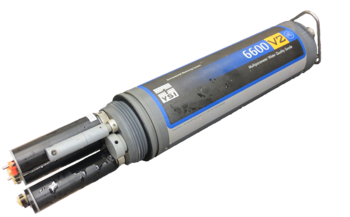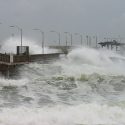Scientists find early warning indicators of major ecological change
Day after day, the buoy bobbed at the surface of Peter Lake. Every five minutes, or 288 times a day, instruments in the water silently recorded samples without creating so much as a ripple. But, beneath the surface, the lake — just across Wisconsin’s northern boundary in Michigan’s Upper Peninsula — was in turmoil. The buoy was busy documenting massive change.
In a new study, researchers from the Center for Limnology at the University of Wisconsin–Madison, say that readings from automated sensors attached to the buoy in Peter Lake forecasted big environmental changes, in some cases more than a year in advance.
The results were published today (Oct. 7, 2013) in the online Early Edition of the Proceedings of the National Academy of Sciences, and they put scientists one step closer to projecting the vulnerability of natural systems to major ecological changes.
Ryan Batt introduces a largemouth bass into Peter Lake in 2009.
Photo: Laura Smith
“From a management perspective this would be extremely useful,” says Ryan Batt, lead author of the report. “If you can see change on the horizon, you can start thinking about doing something about it now, rather than waiting for it to happen.”
Working under the guidance of Steve Carpenter, director of the Center for Limnology, Batt’s team induced what’s called a “trophic cascade” in Peter Lake’s food web by adding a fish-devouring predator, the largemouth bass, to a system dominated by small, plankton-eating fish like pumpkinseed sunfish and golden shiners. Eventually, the ecosystem tipped into a new regime, one ruled by bass.
Throughout the experiment, researchers monitored several variables related to Peter Lake’s metabolism, or the energy moving in and out of the lake through processes like photosynthesis and respiration. Things like dissolved oxygen, pH levels, and chlorophyll, a measurement of plant and algal abundance, are all tied to metabolism. Knowing what the “normal” dynamics of these variables should be, the scientists set up statistical thresholds that would tip them off when something was amiss. If a variable strayed too far for too long beyond normal, an alarm would sound, alerting researchers that the system was about to undergo a big shift.
Researchers called this moment the “day of first alarm,” and, for some variables, the alarm went off more than a year before the system experienced its major shift.
It sounds straightforward but, Batt says, it was a big problem to tackle. “I spent two and a half years analyzing the dataset,” he recalls. “I calculated metabolism a thousand different ways and [in the end] the simplest measurements were better.”

Automated sensors like this one were attached to a buoy in Peter Lake.
Photo: Robert Johnson
Measurements of bigger ecosystem processes, like net ecosystem production, were terrible indicators, Batt found. It was only when he focused on variables like chlorophyll and oxygen — the very numbers he’d been crunching to estimate the more complicated processes — that he saw early signals of ecosystem change.
The researchers then combined their ecosystem forecasting with an algorithm developed during the Cold War as a way to evaluate the threat of missile attacks. They hope this unconventional method of environmental evaluation can become common practice in the field of ecology, where ecosystems around the world are under threat from things like invasive species, pollution, and a warming global average temperature.
Batt says the beauty of this system of detection is that it is a practical approach that takes advantage of the gigantic amount of data being churned out by automated sensors across the globe.
“There’s a lot of this kind of data out there. We’re just saying, ‘Hey here’s something cool we can do with information that we’re already gathering.’ And, it’s using automated systems, which is great because it just wouldn’t be feasible to send someone out to the same location multiple times a day to record these measurements manually.”
Batt hopes the study can help resource managers anticipate negative environmental impacts and address stressors to an ecosystem before things fall apart. When it comes to dealing with negative environmental impacts, preventing collapse is much easier than trying to put all the pieces back together because ecosystem change is often irreversible. Or, as Batt puts it, “When you fall off a cliff you can’t just take one step back to get back to where you were.”
—Adam Hinterthuer
Tags: ecology, environment, limnology, water

